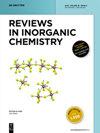The coordination chemistry and supramolecular interactions of 2-(2′-Pyridyl)imidazole ligand: a comprehensive review with theoretical insight
IF 3.1
3区 化学
Q1 CHEMISTRY, INORGANIC & NUCLEAR
引用次数: 0
Abstract
Abstract This review explores the role of 2-(2′-Pyridyl)imidazole (PyimH) as a coordinating ligand and also its role as a supramolecular agent through hydrogen bonding and π⋯π interaction. Two N coordination sites make 2-(2′-Pyridyl)imidazole an analogous ligand to 2,2′-bipyridine. The syn orientation of imidazole and pyridine sp 2 nitrogen makes it a bidentate chelating ligand. PyimH mainly produces discrete coordination complexes (0D), but in a few cases, 1D coordination polymers are observed due to bridging co-ligands like oxalate, dicyanamide, tricyanomethanide, croconate, thiocyanate, and iso-thiocyanate. These discrete coordination units and co-ligand bridged 1D coordination polymers are further augmented to higher dimensional supramolecular systems having linear, zig-zag, ladder-shaped, ribbon-like, and helical geometry. These supramolecular structures are stabilized by intermolecular hydrogen bonding interaction (N–H⋯N, N–H⋯O, O–H⋯N, O–H⋯O, and C–H⋯O) and π⋯π interaction capability of PyimH ligand. PyimH generally acts as an excellent chelating ligand for a range of metal ions and is also a capable supramolecular glueing agent due to hydrogen bonding and π-stacking ability.2-(2 ' -吡啶基)咪唑配体的配位化学和超分子相互作用:具有理论见解的综合综述
本文综述了2-(2 ' -吡啶基)咪唑(PyimH)作为配位体的作用,以及它通过氢键和π⋯π相互作用作为超分子剂的作用。两个N配位使2-(2′-吡啶基)咪唑成为类似于2,2′-联吡啶的配体。咪唑和吡啶sp 2氮的同向取向使其成为双齿螯合配体。PyimH主要产生离散配位配合物(0D),但在少数情况下,由于桥接的共配体,如草酸盐、二氰酰胺、三氰甲烷、croconate、硫氰酸盐和异硫氰酸盐,可以观察到一维配位聚合物。这些离散配位单元和共配体桥接的一维配位聚合物进一步扩展到具有线性、锯齿形、阶梯形、带状和螺旋几何形状的高维超分子体系。这些超分子结构通过分子间氢键相互作用(N - h⋯N, N - h⋯O, O - h⋯N, O - h⋯O和C-H⋯O)和PyimH配体的π⋯π相互作用能力来稳定。PyimH通常作为一系列金属离子的优秀螯合配体,由于氢键和π堆积能力,它也是一种功能强大的超分子胶合剂。
本文章由计算机程序翻译,如有差异,请以英文原文为准。
求助全文
约1分钟内获得全文
求助全文
来源期刊

Reviews in Inorganic Chemistry
化学-分析化学
CiteScore
7.30
自引率
4.90%
发文量
20
审稿时长
1 months
期刊介绍:
Reviews in Inorganic Chemistry (REVIC) is a quarterly, peer-reviewed journal that focuses on developments in inorganic chemistry. Technical reviews offer detailed synthesis protocols, reviews of methodology and descriptions of apparatus. Topics are treated from a synthetic, theoretical, or analytical perspective. The editors and the publisher are committed to high quality standards and rapid handling of the review and publication process. The journal publishes all aspects of solid-state, molecular and surface chemistry. Topics may be treated from a synthetic, theoretical, or analytical perspective. The editors and the publisher are commited to high quality standards and rapid handling of the review and publication process.
Topics:
-Main group chemistry-
Transition metal chemistry-
Coordination chemistry-
Organometallic chemistry-
Catalysis-
Bioinorganic chemistry-
Supramolecular chemistry-
Ionic liquids
 求助内容:
求助内容: 应助结果提醒方式:
应助结果提醒方式:


